【核心素养目标】Unit 5 Educational exchanges Period 3 Grammar 教案
文档属性
| 名称 | 【核心素养目标】Unit 5 Educational exchanges Period 3 Grammar 教案 | 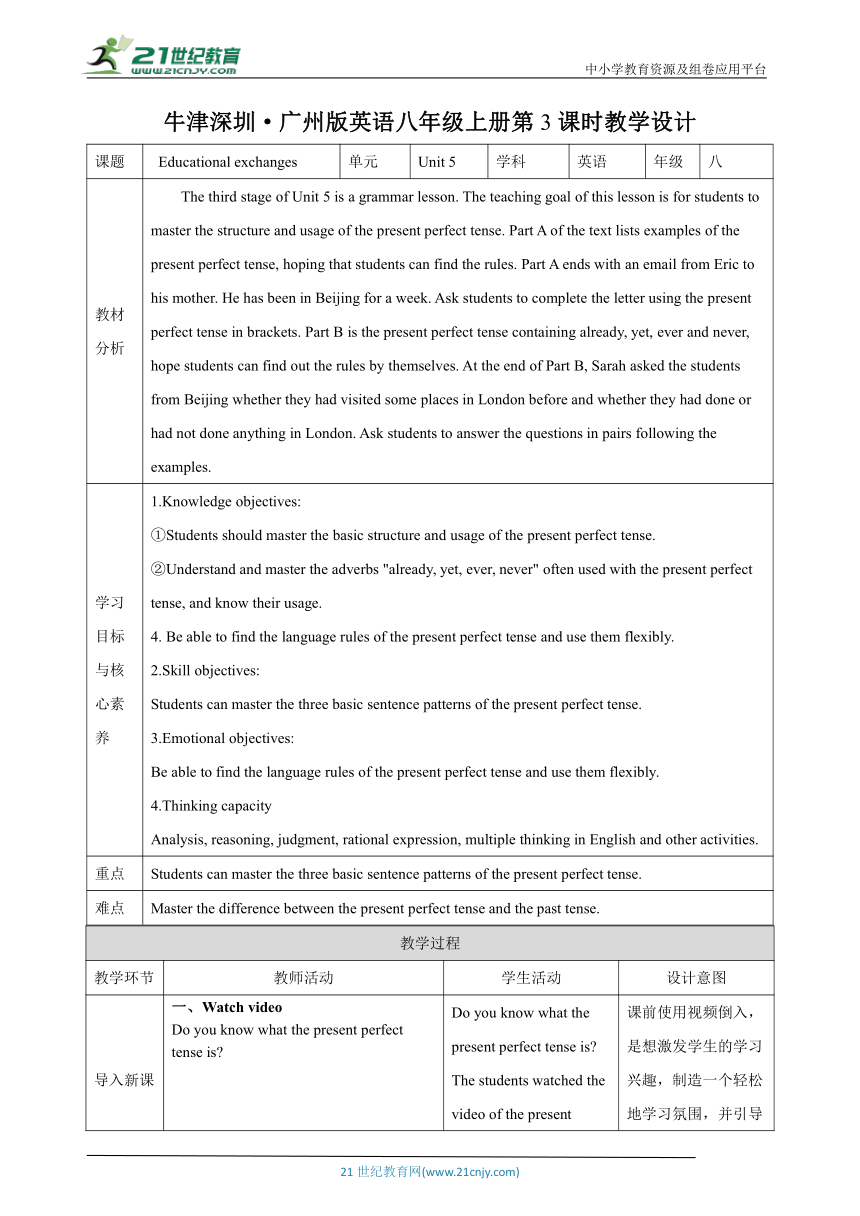 | |
| 格式 | docx | ||
| 文件大小 | 4.0MB | ||
| 资源类型 | 试卷 | ||
| 版本资源 | 牛津深圳版 | ||
| 科目 | 英语 | ||
| 更新时间 | 2022-10-17 16:23:02 | ||
图片预览

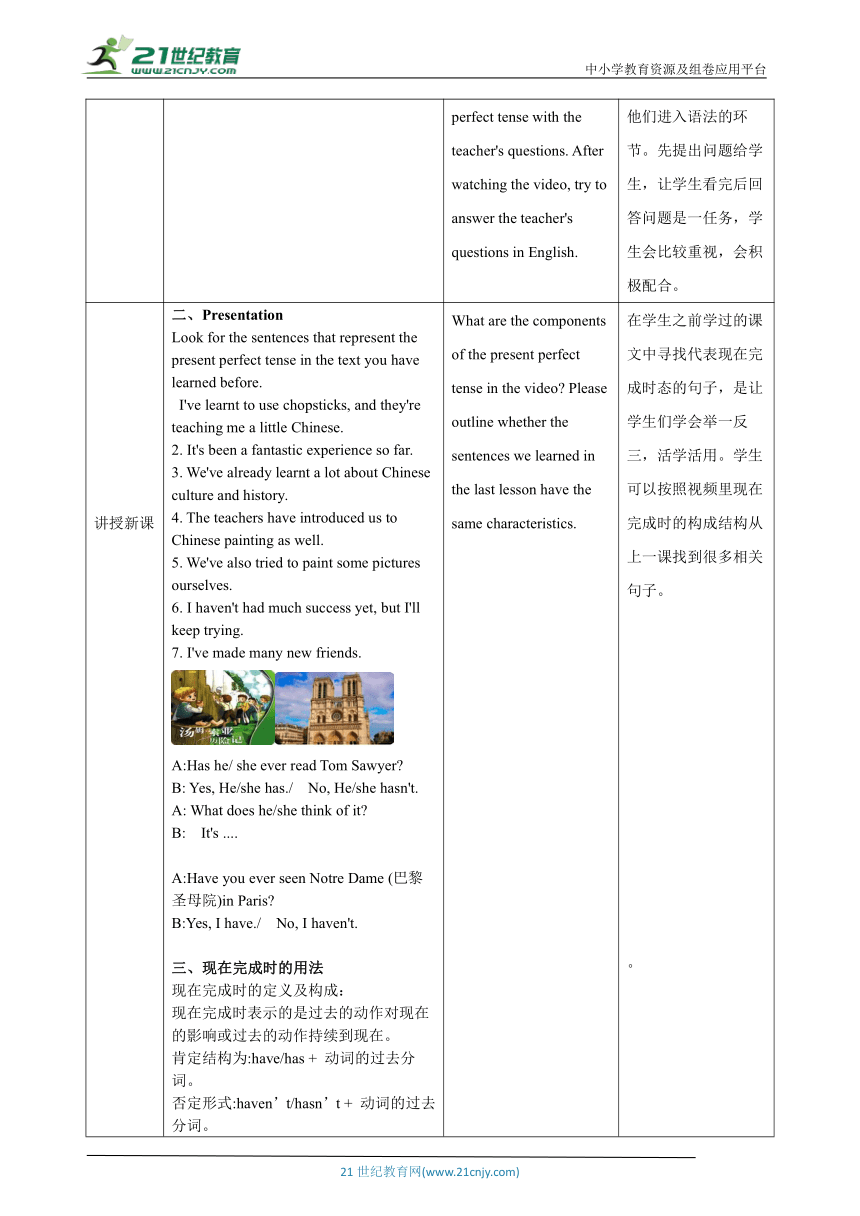
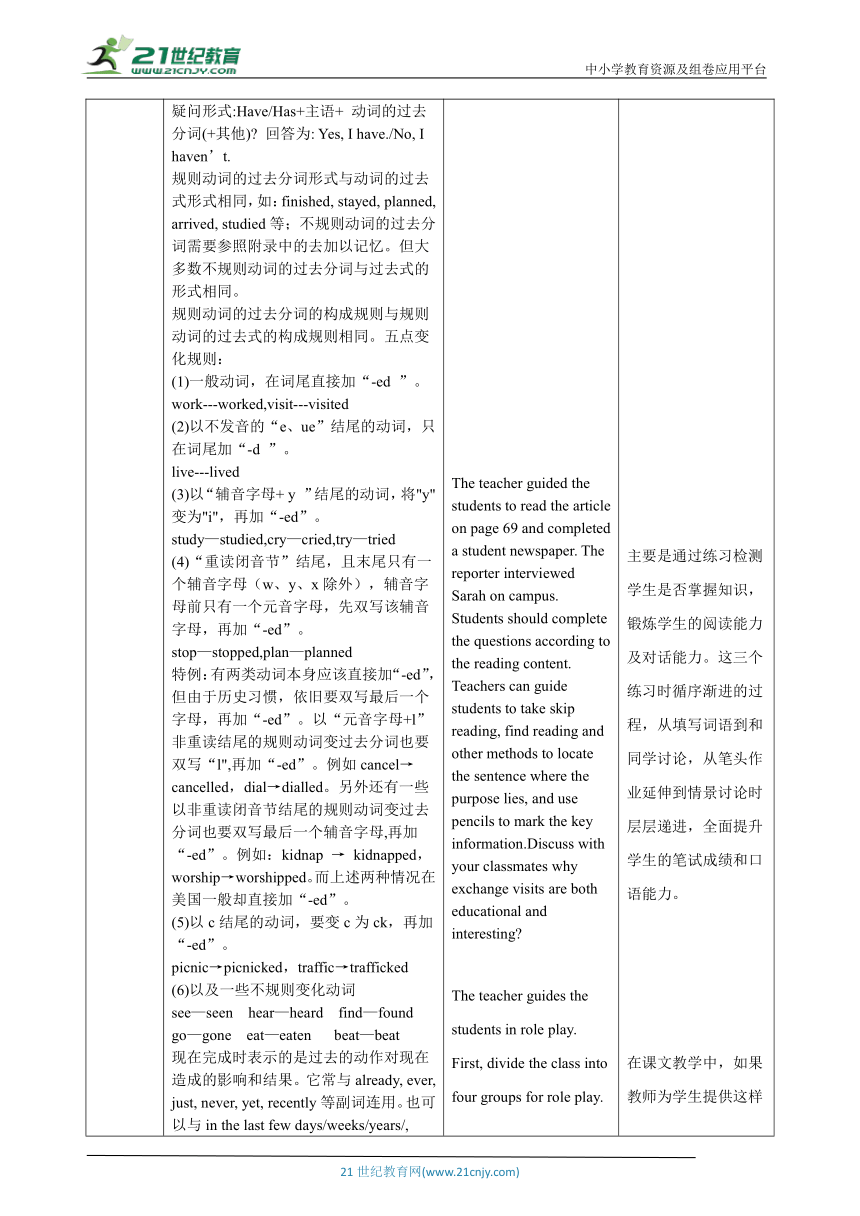
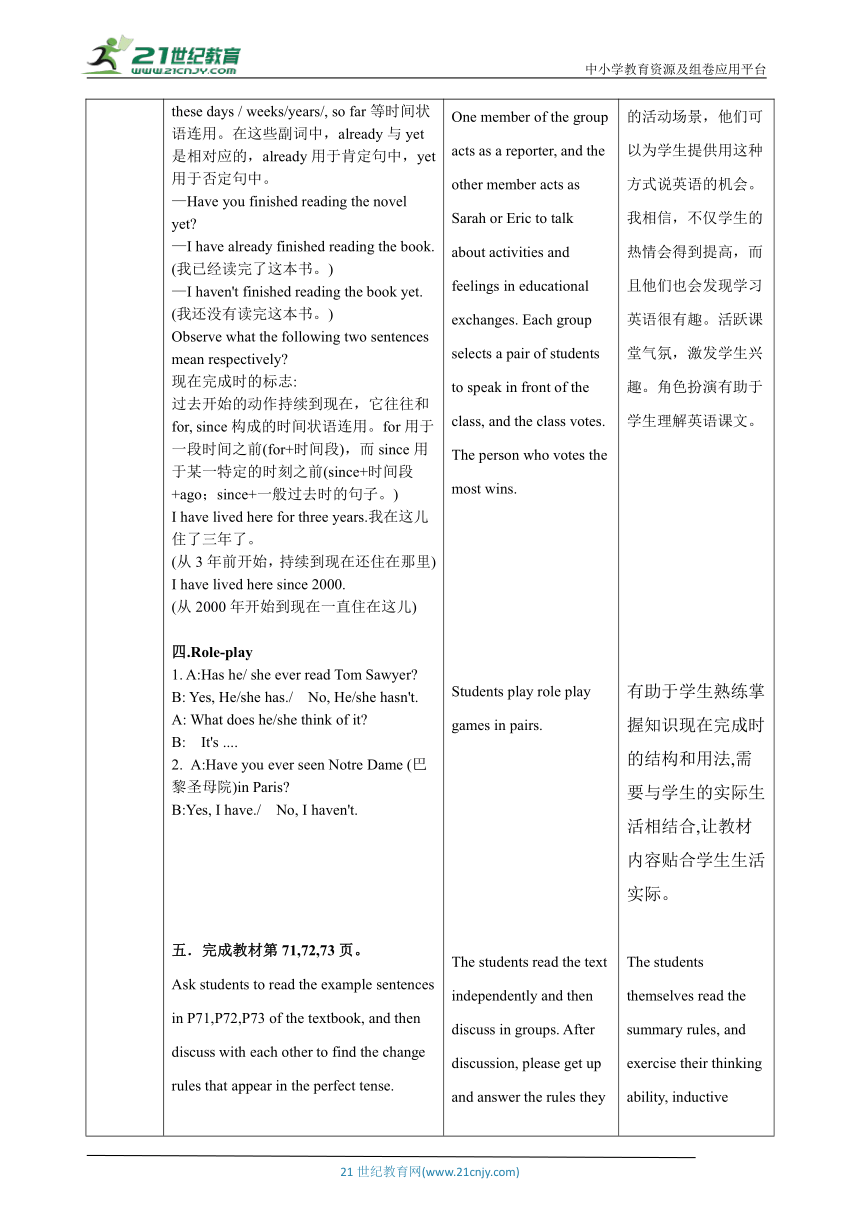
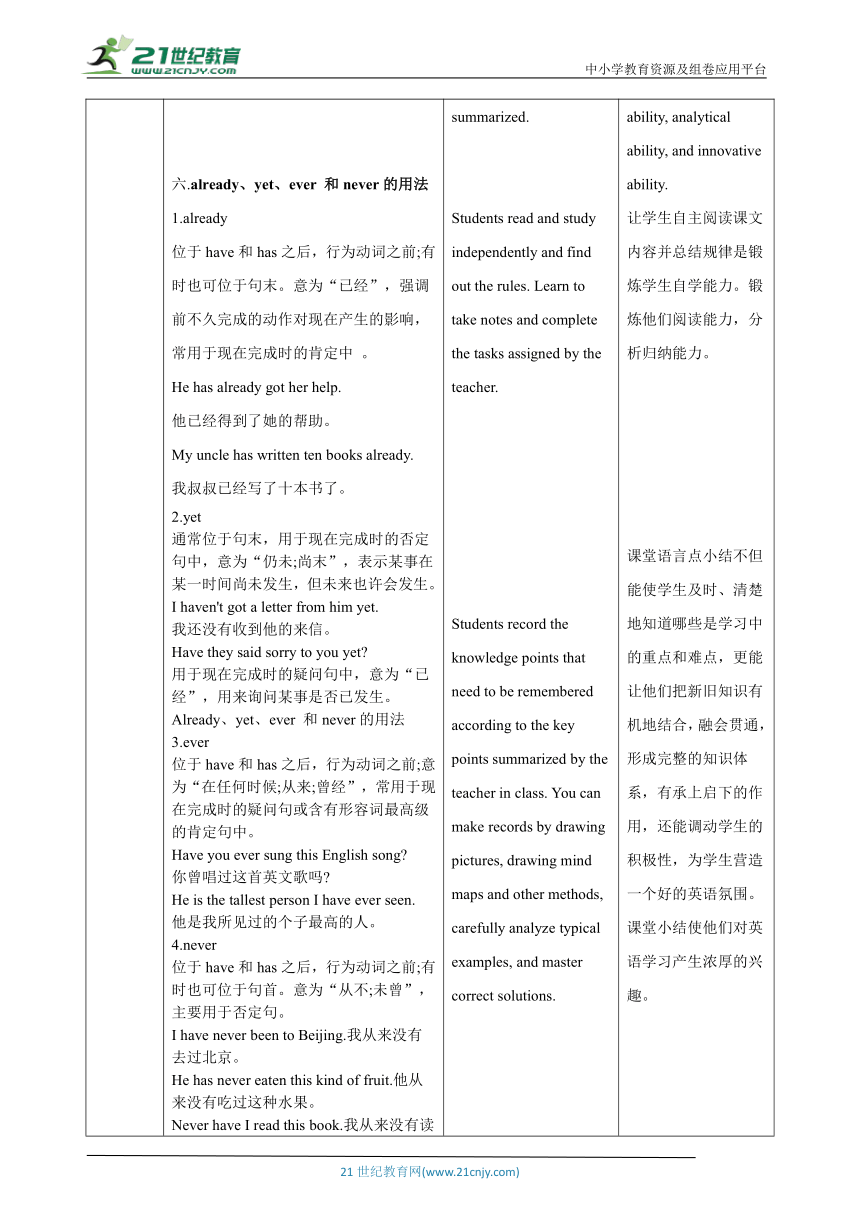
文档简介
中小学教育资源及组卷应用平台
牛津深圳·广州版英语八年级上册第3课时教学设计
课题 Educational exchanges 单元 Unit 5 学科 英语 年级 八
教材分析 The third stage of Unit 5 is a grammar lesson. The teaching goal of this lesson is for students to master the structure and usage of the present perfect tense. Part A of the text lists examples of the present perfect tense, hoping that students can find the rules. Part A ends with an email from Eric to his mother. He has been in Beijing for a week. Ask students to complete the letter using the present perfect tense in brackets. Part B is the present perfect tense containing already, yet, ever and never, hope students can find out the rules by themselves. At the end of Part B, Sarah asked the students from Beijing whether they had visited some places in London before and whether they had done or had not done anything in London. Ask students to answer the questions in pairs following the examples.
学习 目标与核心素养 1.Knowledge objectives: ①Students should master the basic structure and usage of the present perfect tense. ②Understand and master the adverbs "already, yet, ever, never" often used with the present perfect tense, and know their usage. 4. Be able to find the language rules of the present perfect tense and use them flexibly. 2.Skill objectives: Students can master the three basic sentence patterns of the present perfect tense. 3.Emotional objectives: Be able to find the language rules of the present perfect tense and use them flexibly. 4.Thinking capacity Analysis, reasoning, judgment, rational expression, multiple thinking in English and other activities.
重点 Students can master the three basic sentence patterns of the present perfect tense.
难点 Master the difference between the present perfect tense and the past tense.
教学过程
教学环节 教师活动 学生活动 设计意图
导入新课 一、Watch video Do you know what the present perfect tense is Do you know what the present perfect tense is The students watched the video of the present perfect tense with the teacher's questions. After watching the video, try to answer the teacher's questions in English. 课前使用视频倒入,是想激发学生的学习兴趣,制造一个轻松地学习氛围,并引导他们进入语法的环节。先提出问题给学生,让学生看完后回答问题是一任务,学生会比较重视,会积极配合。
讲授新课 二、Presentation Look for the sentences that represent the present perfect tense in the text you have learned before. I've learnt to use chopsticks, and they're teaching me a little Chinese. 2. It's been a fantastic experience so far. 3. We've already learnt a lot about Chinese culture and history. 4. The teachers have introduced us to Chinese painting as well. 5. We've also tried to paint some pictures ourselves. 6. I haven't had much success yet, but I'll keep trying. 7. I've made many new friends. A:Has he/ she ever read Tom Sawyer B: Yes, He/she has./ No, He/she hasn't. A: What does he/she think of it B: It's .... A:Have you ever seen Notre Dame (巴黎圣母院)in Paris B:Yes, I have./ No, I haven't. 三、现在完成时的用法 现在完成时的定义及构成: 现在完成时表示的是过去的动作对现在的影响或过去的动作持续到现在。 肯定结构为:have/has + 动词的过去分词。 否定形式:haven’t/hasn’t + 动词的过去分词。 疑问形式:Have/Has+主语+ 动词的过去分词(+其他) 回答为: Yes, I have./No, I haven’t. 规则动词的过去分词形式与动词的过去式形式相同,如:finished, stayed, planned, arrived, studied等;不规则动词的过去分词需要参照附录中的去加以记忆。但大多数不规则动词的过去分词与过去式的形式相同。 规则动词的过去分词的构成规则与规则动词的过去式的构成规则相同。五点变化规则: (1)一般动词,在词尾直接加“-ed ”。 work---worked,visit---visited (2)以不发音的“e、ue”结尾的动词,只在词尾加“-d ”。 live---lived (3)以“辅音字母+ y ”结尾的动词,将"y"变为"i",再加“-ed”。 study—studied,cry—cried,try—tried (4)“重读闭音节”结尾,且末尾只有一个辅音字母(w、y、x除外),辅音字母前只有一个元音字母,先双写该辅音字母,再加“-ed”。 stop—stopped,plan—planned 特例:有两类动词本身应该直接加“-ed”,但由于历史习惯,依旧要双写最后一个字母,再加“-ed”。以“元音字母+l”非重读结尾的规则动词变过去分词也要双写“l",再加“-ed”。例如cancel→cancelled,dial→dialled。另外还有一些以非重读闭音节结尾的规则动词变过去分词也要双写最后一个辅音字母,再加“-ed”。例如:kidnap → kidnapped,worship→worshipped。而上述两种情况在美国一般却直接加“-ed”。 (5)以c结尾的动词,要变c为ck,再加“-ed”。 picnic→picnicked,traffic→trafficked (6)以及一些不规则变化动词 see—seen hear—heard find—found go—gone eat—eaten beat—beat 现在完成时表示的是过去的动作对现在造成的影响和结果。它常与already, ever, just, never, yet, recently等副词连用。也可以与in the last few days/weeks/years/, these days / weeks/years/, so far等时间状语连用。在这些副词中,already与yet是相对应的,already用于肯定句中,yet用于否定句中。 —Have you finished reading the novel yet —I have already finished reading the book. (我已经读完了这本书。) —I haven't finished reading the book yet. (我还没有读完这本书。) Observe what the following two sentences mean respectively 现在完成时的标志: 过去开始的动作持续到现在,它往往和for, since构成的时间状语连用。for用于一段时间之前(for+时间段),而since用于某一特定的时刻之前(since+时间段+ago;since+一般过去时的句子。) I have lived here for three years.我在这儿住了三年了。 (从3年前开始,持续到现在还住在那里) I have lived here since 2000. (从2000年开始到现在一直住在这儿) 四.Role-play 1. A:Has he/ she ever read Tom Sawyer B: Yes, He/she has./ No, He/she hasn't. A: What does he/she think of it B: It's .... A:Have you ever seen Notre Dame (巴黎圣母院)in Paris B:Yes, I have./ No, I haven't. 五.完成教材第71,72,73页。 Ask students to read the example sentences in P71,P72,P73 of the textbook, and then discuss with each other to find the change rules that appear in the perfect tense. 六.already、yet、ever 和never的用法 1.already 位于have和has之后,行为动词之前;有时也可位于句末。意为“已经”,强调前不久完成的动作对现在产生的影响,常用于现在完成时的肯定中 。 He has already got her help. 他已经得到了她的帮助。 My uncle has written ten books already. 我叔叔已经写了十本书了。 2.yet 通常位于句末,用于现在完成时的否定句中,意为“仍未;尚末”,表示某事在某一时间尚未发生,但未来也许会发生。 I haven't got a letter from him yet. 我还没有收到他的来信。 Have they said sorry to you yet 用于现在完成时的疑问句中,意为“已经”,用来询问某事是否已发生。 Already、yet、ever 和never的用法 3.ever 位于have和has之后,行为动词之前;意为“在任何时候;从来;曾经”,常用于现在完成时的疑问句或含有形容词最高级的肯定句中。 Have you ever sung this English song 你曾唱过这首英文歌吗 He is the tallest person I have ever seen. 他是我所见过的个子最高的人。 4.never 位于have和has之后,行为动词之前;有时也可位于句首。意为“从不;未曾”,主要用于否定句。 I have never been to Beijing.我从来没有去过北京。 He has never eaten this kind of fruit.他从来没有吃过这种水果。 Never have I read this book.我从来没有读过这本书。 七.Team racing 1.全班分成四个大组。 2.根据以下图片和文本提示,使用现在完成时态补充句子。 3.哪个小组先答出来得一分,总分五分。 他们乘公共汽车去了香港迪斯尼乐园。 __________________________________. They have gone to Hong Kong Disneyland by bus. 你曾经游览过北京故宫吗? _________________________________ Have you ever been to Beijing to see the Palace Museum. 你曾经游览过天坛吗? ___________________________________ Have you ever visited the Temple of Heaven 你曾经游览过长城吗? ___________________________________ Have you ever visited the Great Wall 七、Language point However, I haven't visited the Great wall yet, and I haven't done any shopping either. I'll do these things next week.然而,我还没有参观长城,也没有购物。我下周要做这些事。 1. too和as well多用于口语中,语气较轻,通常用于肯定句或疑问句,一般不用于否定句,且通常放在句末。too 有时也紧跟在主语后(注:as well 不这样用),此用法较正式。 2. also 比 too 和 as well 正式,一般也不用于否定句,它在句中的位置通常是紧靠动词,即放在行为动词之前,特殊动词之后。有时为了强调也放在句末(但不常见)。 3. either(也)通常只用于否定句,且要放在句末。 注:有时在肯定句之后跟一个否定句,可能用 too,also。如: He came, but she didn’t also came. 他来了,但她没有也一起来。 He went to Washington, but not to New York too. 他去了华盛顿,但并不是也去了纽约。 比较: He didn’t buy a computer, and she didn’t either. 他没有买电脑,她也没有买。 He bought a computer, but she didn’t too. 他买了台电脑,但她没有也买台电脑。 What are the components of the present perfect tense in the video Please outline whether the sentences we learned in the last lesson have the same characteristics. The teacher guided the students to read the article on page 69 and completed a student newspaper. The reporter interviewed Sarah on campus. Students should complete the questions according to the reading content. Teachers can guide students to take skip reading, find reading and other methods to locate the sentence where the purpose lies, and use pencils to mark the key information.Discuss with your classmates why exchange visits are both educational and interesting The teacher guides the students in role play. First, divide the class into four groups for role play. One member of the group acts as a reporter, and the other member acts as Sarah or Eric to talk about activities and feelings in educational exchanges. Each group selects a pair of students to speak in front of the class, and the class votes. The person who votes the most wins. Students play role play games in pairs. The students read the text independently and then discuss in groups. After discussion, please get up and answer the rules they summarized. Students read and study independently and find out the rules. Learn to take notes and complete the tasks assigned by the teacher. Students record the knowledge points that need to be remembered according to the key points summarized by the teacher in class. You can make records by drawing pictures, drawing mind maps and other methods, carefully analyze typical examples, and master correct solutions. 在学生之前学过的课文中寻找代表现在完成时态的句子,是让学生们学会举一反三,活学活用。学生可以按照视频里现在完成时的构成结构从上一课找到很多相关句子。 。 主要是通过练习检测学生是否掌握知识,锻炼学生的阅读能力及对话能力。这三个练习时循序渐进的过程,从填写词语到和同学讨论,从笔头作业延伸到情景讨论时层层递进,全面提升学生的笔试成绩和口语能力。 在课文教学中,如果教师为学生提供这样的活动场景,他们可以为学生提供用这种方式说英语的机会。我相信,不仅学生的热情会得到提高,而且他们也会发现学习英语很有趣。活跃课堂气氛,激发学生兴趣。角色扮演有助于学生理解英语课文。 有助于学生熟练掌握知识现在完成时的结构和用法,需要与学生的实际生活相结合,让教材内容贴合学生生活实际。 The students themselves read the summary rules, and exercise their thinking ability, inductive ability, analytical ability, and innovative ability. 让学生自主阅读课文内容并总结规律是锻炼学生自学能力。锻炼他们阅读能力,分析归纳能力。 课堂语言点小结不但能使学生及时、清楚地知道哪些是学习中的重点和难点,更能让他们把新旧知识有机地结合,融会贯通,形成完整的知识体系,有承上启下的作用,还能调动学生的积极性,为学生营造一个好的英语氛围。课堂小结使他们对英语学习产生浓厚的兴趣。
课堂练习 一.单项选择 1、Both his parents look sad . Maybe they ____what's happened to him . A. knew B. have known C. must know D.will know 2、He has _______ been to Shanghai , has he A. already B.never C.ever D. still 3、Have you met Mr Li ______? A. just B. ago C.before D. a moment ago 4、The famous writer _____ one new book in the past two year . A. is writing B.was writing C.wrote D.has written 5、—Our country ______ a lot so far . —Yes . I hope it will be even ______ . A. has changed ; well B. changed ; good C. has changed ; better D. changed ; better 1.B2.B3.C 4.D5.C 二、句型转换 1、He has never surfed, _______ (改成反意疑问句) 2、They have been here since 2000. (对划线部分提问) __________ have they been here 3、The old man _____ last year. He______________for a year.(die) (动词填空) 4、This factory opened twenty years ago.(同义句转换) This factory______________ for twenty years. 5、Miss Gao left an hour ago. (同义句转换) Miss Gao ________ _______ _________ an hour ago. 1.has he 2.How long died 3.has been dead 4.has been open 5.has been away 课堂练习有利于学生从中了解是否掌握重要词汇及句型,语法。 课堂练习是对教师对一堂课的高度提炼与概括,要能突出重点、难点,教师还把所有知识点交织成完整的知识网,便于学生复习和自查。
课堂小结 The third stage of Unit 5 is grammar. Students should master the structure and usage of the present perfect tense. Part A ends with an email from Eric to his mother. He has been in Beijing for a week. Have students complete the letter in the present perfect tense in brackets. Part B is the present perfect tense, including the past, however, ever and never. At the end of Part B, Sarah asked the students in Beijing whether they had been to some places in London before and what they had done in London. Ask students to answer the questions in pairs according to the examples. 教师总结复习的知识点,回顾这节课课程的内容及学习目标,需要注意的情况,加深学生的记忆。
板书 现在完成时的定义及构成: 现在完成时表示的是过去的动作对现在的影响或过去的动作持续到现在。 肯定结构为:have/has + 动词的过去分词。 否定形式:haven’t/hasn’t + 动词的过去分词。 疑问形式:Have/Has+主语+ 动词的过去分词(+其他) 回答为: Yes, I have./No, I haven’t.
21世纪教育网 www.21cnjy.com 精品试卷·第 2 页 (共 2 页)
21世纪教育网(www.21cnjy.com)
牛津深圳·广州版英语八年级上册第3课时教学设计
课题 Educational exchanges 单元 Unit 5 学科 英语 年级 八
教材分析 The third stage of Unit 5 is a grammar lesson. The teaching goal of this lesson is for students to master the structure and usage of the present perfect tense. Part A of the text lists examples of the present perfect tense, hoping that students can find the rules. Part A ends with an email from Eric to his mother. He has been in Beijing for a week. Ask students to complete the letter using the present perfect tense in brackets. Part B is the present perfect tense containing already, yet, ever and never, hope students can find out the rules by themselves. At the end of Part B, Sarah asked the students from Beijing whether they had visited some places in London before and whether they had done or had not done anything in London. Ask students to answer the questions in pairs following the examples.
学习 目标与核心素养 1.Knowledge objectives: ①Students should master the basic structure and usage of the present perfect tense. ②Understand and master the adverbs "already, yet, ever, never" often used with the present perfect tense, and know their usage. 4. Be able to find the language rules of the present perfect tense and use them flexibly. 2.Skill objectives: Students can master the three basic sentence patterns of the present perfect tense. 3.Emotional objectives: Be able to find the language rules of the present perfect tense and use them flexibly. 4.Thinking capacity Analysis, reasoning, judgment, rational expression, multiple thinking in English and other activities.
重点 Students can master the three basic sentence patterns of the present perfect tense.
难点 Master the difference between the present perfect tense and the past tense.
教学过程
教学环节 教师活动 学生活动 设计意图
导入新课 一、Watch video Do you know what the present perfect tense is Do you know what the present perfect tense is The students watched the video of the present perfect tense with the teacher's questions. After watching the video, try to answer the teacher's questions in English. 课前使用视频倒入,是想激发学生的学习兴趣,制造一个轻松地学习氛围,并引导他们进入语法的环节。先提出问题给学生,让学生看完后回答问题是一任务,学生会比较重视,会积极配合。
讲授新课 二、Presentation Look for the sentences that represent the present perfect tense in the text you have learned before. I've learnt to use chopsticks, and they're teaching me a little Chinese. 2. It's been a fantastic experience so far. 3. We've already learnt a lot about Chinese culture and history. 4. The teachers have introduced us to Chinese painting as well. 5. We've also tried to paint some pictures ourselves. 6. I haven't had much success yet, but I'll keep trying. 7. I've made many new friends. A:Has he/ she ever read Tom Sawyer B: Yes, He/she has./ No, He/she hasn't. A: What does he/she think of it B: It's .... A:Have you ever seen Notre Dame (巴黎圣母院)in Paris B:Yes, I have./ No, I haven't. 三、现在完成时的用法 现在完成时的定义及构成: 现在完成时表示的是过去的动作对现在的影响或过去的动作持续到现在。 肯定结构为:have/has + 动词的过去分词。 否定形式:haven’t/hasn’t + 动词的过去分词。 疑问形式:Have/Has+主语+ 动词的过去分词(+其他) 回答为: Yes, I have./No, I haven’t. 规则动词的过去分词形式与动词的过去式形式相同,如:finished, stayed, planned, arrived, studied等;不规则动词的过去分词需要参照附录中的去加以记忆。但大多数不规则动词的过去分词与过去式的形式相同。 规则动词的过去分词的构成规则与规则动词的过去式的构成规则相同。五点变化规则: (1)一般动词,在词尾直接加“-ed ”。 work---worked,visit---visited (2)以不发音的“e、ue”结尾的动词,只在词尾加“-d ”。 live---lived (3)以“辅音字母+ y ”结尾的动词,将"y"变为"i",再加“-ed”。 study—studied,cry—cried,try—tried (4)“重读闭音节”结尾,且末尾只有一个辅音字母(w、y、x除外),辅音字母前只有一个元音字母,先双写该辅音字母,再加“-ed”。 stop—stopped,plan—planned 特例:有两类动词本身应该直接加“-ed”,但由于历史习惯,依旧要双写最后一个字母,再加“-ed”。以“元音字母+l”非重读结尾的规则动词变过去分词也要双写“l",再加“-ed”。例如cancel→cancelled,dial→dialled。另外还有一些以非重读闭音节结尾的规则动词变过去分词也要双写最后一个辅音字母,再加“-ed”。例如:kidnap → kidnapped,worship→worshipped。而上述两种情况在美国一般却直接加“-ed”。 (5)以c结尾的动词,要变c为ck,再加“-ed”。 picnic→picnicked,traffic→trafficked (6)以及一些不规则变化动词 see—seen hear—heard find—found go—gone eat—eaten beat—beat 现在完成时表示的是过去的动作对现在造成的影响和结果。它常与already, ever, just, never, yet, recently等副词连用。也可以与in the last few days/weeks/years/, these days / weeks/years/, so far等时间状语连用。在这些副词中,already与yet是相对应的,already用于肯定句中,yet用于否定句中。 —Have you finished reading the novel yet —I have already finished reading the book. (我已经读完了这本书。) —I haven't finished reading the book yet. (我还没有读完这本书。) Observe what the following two sentences mean respectively 现在完成时的标志: 过去开始的动作持续到现在,它往往和for, since构成的时间状语连用。for用于一段时间之前(for+时间段),而since用于某一特定的时刻之前(since+时间段+ago;since+一般过去时的句子。) I have lived here for three years.我在这儿住了三年了。 (从3年前开始,持续到现在还住在那里) I have lived here since 2000. (从2000年开始到现在一直住在这儿) 四.Role-play 1. A:Has he/ she ever read Tom Sawyer B: Yes, He/she has./ No, He/she hasn't. A: What does he/she think of it B: It's .... A:Have you ever seen Notre Dame (巴黎圣母院)in Paris B:Yes, I have./ No, I haven't. 五.完成教材第71,72,73页。 Ask students to read the example sentences in P71,P72,P73 of the textbook, and then discuss with each other to find the change rules that appear in the perfect tense. 六.already、yet、ever 和never的用法 1.already 位于have和has之后,行为动词之前;有时也可位于句末。意为“已经”,强调前不久完成的动作对现在产生的影响,常用于现在完成时的肯定中 。 He has already got her help. 他已经得到了她的帮助。 My uncle has written ten books already. 我叔叔已经写了十本书了。 2.yet 通常位于句末,用于现在完成时的否定句中,意为“仍未;尚末”,表示某事在某一时间尚未发生,但未来也许会发生。 I haven't got a letter from him yet. 我还没有收到他的来信。 Have they said sorry to you yet 用于现在完成时的疑问句中,意为“已经”,用来询问某事是否已发生。 Already、yet、ever 和never的用法 3.ever 位于have和has之后,行为动词之前;意为“在任何时候;从来;曾经”,常用于现在完成时的疑问句或含有形容词最高级的肯定句中。 Have you ever sung this English song 你曾唱过这首英文歌吗 He is the tallest person I have ever seen. 他是我所见过的个子最高的人。 4.never 位于have和has之后,行为动词之前;有时也可位于句首。意为“从不;未曾”,主要用于否定句。 I have never been to Beijing.我从来没有去过北京。 He has never eaten this kind of fruit.他从来没有吃过这种水果。 Never have I read this book.我从来没有读过这本书。 七.Team racing 1.全班分成四个大组。 2.根据以下图片和文本提示,使用现在完成时态补充句子。 3.哪个小组先答出来得一分,总分五分。 他们乘公共汽车去了香港迪斯尼乐园。 __________________________________. They have gone to Hong Kong Disneyland by bus. 你曾经游览过北京故宫吗? _________________________________ Have you ever been to Beijing to see the Palace Museum. 你曾经游览过天坛吗? ___________________________________ Have you ever visited the Temple of Heaven 你曾经游览过长城吗? ___________________________________ Have you ever visited the Great Wall 七、Language point However, I haven't visited the Great wall yet, and I haven't done any shopping either. I'll do these things next week.然而,我还没有参观长城,也没有购物。我下周要做这些事。 1. too和as well多用于口语中,语气较轻,通常用于肯定句或疑问句,一般不用于否定句,且通常放在句末。too 有时也紧跟在主语后(注:as well 不这样用),此用法较正式。 2. also 比 too 和 as well 正式,一般也不用于否定句,它在句中的位置通常是紧靠动词,即放在行为动词之前,特殊动词之后。有时为了强调也放在句末(但不常见)。 3. either(也)通常只用于否定句,且要放在句末。 注:有时在肯定句之后跟一个否定句,可能用 too,also。如: He came, but she didn’t also came. 他来了,但她没有也一起来。 He went to Washington, but not to New York too. 他去了华盛顿,但并不是也去了纽约。 比较: He didn’t buy a computer, and she didn’t either. 他没有买电脑,她也没有买。 He bought a computer, but she didn’t too. 他买了台电脑,但她没有也买台电脑。 What are the components of the present perfect tense in the video Please outline whether the sentences we learned in the last lesson have the same characteristics. The teacher guided the students to read the article on page 69 and completed a student newspaper. The reporter interviewed Sarah on campus. Students should complete the questions according to the reading content. Teachers can guide students to take skip reading, find reading and other methods to locate the sentence where the purpose lies, and use pencils to mark the key information.Discuss with your classmates why exchange visits are both educational and interesting The teacher guides the students in role play. First, divide the class into four groups for role play. One member of the group acts as a reporter, and the other member acts as Sarah or Eric to talk about activities and feelings in educational exchanges. Each group selects a pair of students to speak in front of the class, and the class votes. The person who votes the most wins. Students play role play games in pairs. The students read the text independently and then discuss in groups. After discussion, please get up and answer the rules they summarized. Students read and study independently and find out the rules. Learn to take notes and complete the tasks assigned by the teacher. Students record the knowledge points that need to be remembered according to the key points summarized by the teacher in class. You can make records by drawing pictures, drawing mind maps and other methods, carefully analyze typical examples, and master correct solutions. 在学生之前学过的课文中寻找代表现在完成时态的句子,是让学生们学会举一反三,活学活用。学生可以按照视频里现在完成时的构成结构从上一课找到很多相关句子。 。 主要是通过练习检测学生是否掌握知识,锻炼学生的阅读能力及对话能力。这三个练习时循序渐进的过程,从填写词语到和同学讨论,从笔头作业延伸到情景讨论时层层递进,全面提升学生的笔试成绩和口语能力。 在课文教学中,如果教师为学生提供这样的活动场景,他们可以为学生提供用这种方式说英语的机会。我相信,不仅学生的热情会得到提高,而且他们也会发现学习英语很有趣。活跃课堂气氛,激发学生兴趣。角色扮演有助于学生理解英语课文。 有助于学生熟练掌握知识现在完成时的结构和用法,需要与学生的实际生活相结合,让教材内容贴合学生生活实际。 The students themselves read the summary rules, and exercise their thinking ability, inductive ability, analytical ability, and innovative ability. 让学生自主阅读课文内容并总结规律是锻炼学生自学能力。锻炼他们阅读能力,分析归纳能力。 课堂语言点小结不但能使学生及时、清楚地知道哪些是学习中的重点和难点,更能让他们把新旧知识有机地结合,融会贯通,形成完整的知识体系,有承上启下的作用,还能调动学生的积极性,为学生营造一个好的英语氛围。课堂小结使他们对英语学习产生浓厚的兴趣。
课堂练习 一.单项选择 1、Both his parents look sad . Maybe they ____what's happened to him . A. knew B. have known C. must know D.will know 2、He has _______ been to Shanghai , has he A. already B.never C.ever D. still 3、Have you met Mr Li ______? A. just B. ago C.before D. a moment ago 4、The famous writer _____ one new book in the past two year . A. is writing B.was writing C.wrote D.has written 5、—Our country ______ a lot so far . —Yes . I hope it will be even ______ . A. has changed ; well B. changed ; good C. has changed ; better D. changed ; better 1.B2.B3.C 4.D5.C 二、句型转换 1、He has never surfed, _______ (改成反意疑问句) 2、They have been here since 2000. (对划线部分提问) __________ have they been here 3、The old man _____ last year. He______________for a year.(die) (动词填空) 4、This factory opened twenty years ago.(同义句转换) This factory______________ for twenty years. 5、Miss Gao left an hour ago. (同义句转换) Miss Gao ________ _______ _________ an hour ago. 1.has he 2.How long died 3.has been dead 4.has been open 5.has been away 课堂练习有利于学生从中了解是否掌握重要词汇及句型,语法。 课堂练习是对教师对一堂课的高度提炼与概括,要能突出重点、难点,教师还把所有知识点交织成完整的知识网,便于学生复习和自查。
课堂小结 The third stage of Unit 5 is grammar. Students should master the structure and usage of the present perfect tense. Part A ends with an email from Eric to his mother. He has been in Beijing for a week. Have students complete the letter in the present perfect tense in brackets. Part B is the present perfect tense, including the past, however, ever and never. At the end of Part B, Sarah asked the students in Beijing whether they had been to some places in London before and what they had done in London. Ask students to answer the questions in pairs according to the examples. 教师总结复习的知识点,回顾这节课课程的内容及学习目标,需要注意的情况,加深学生的记忆。
板书 现在完成时的定义及构成: 现在完成时表示的是过去的动作对现在的影响或过去的动作持续到现在。 肯定结构为:have/has + 动词的过去分词。 否定形式:haven’t/hasn’t + 动词的过去分词。 疑问形式:Have/Has+主语+ 动词的过去分词(+其他) 回答为: Yes, I have./No, I haven’t.
21世纪教育网 www.21cnjy.com 精品试卷·第 2 页 (共 2 页)
21世纪教育网(www.21cnjy.com)
